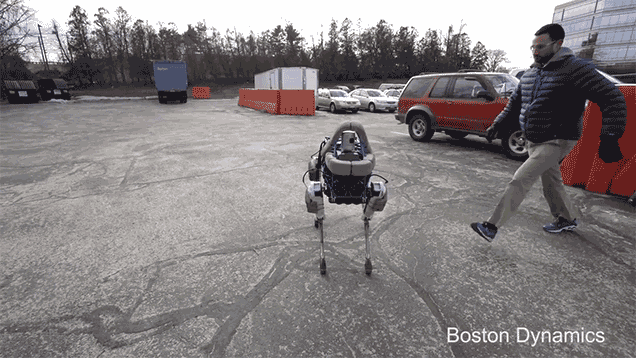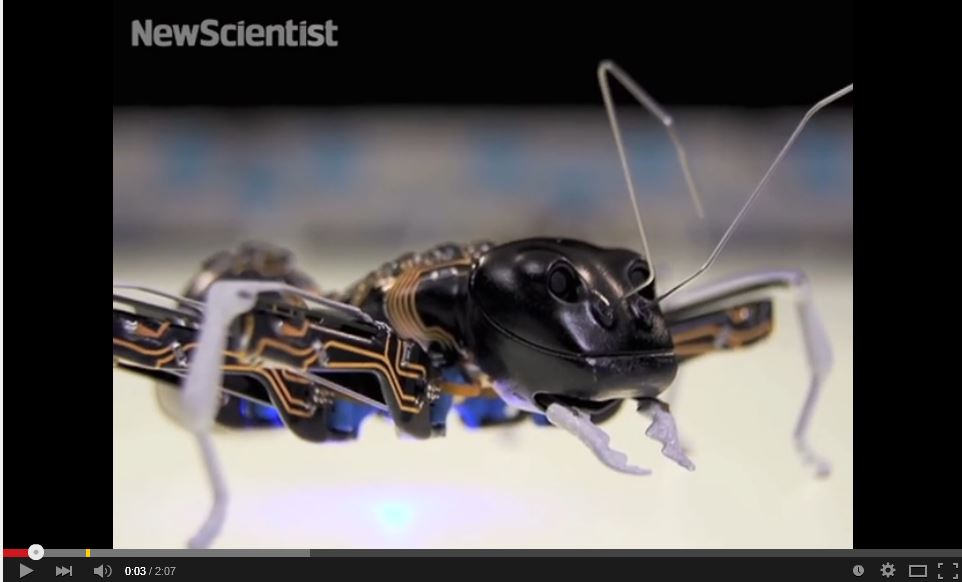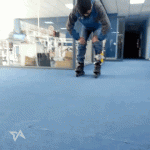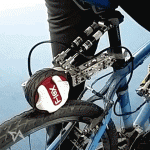Jun 15
3
跳躍的機器獵豹(cheetah)
麻省理工學院的研究人員是誰建一個機器人獵豹現在已經訓練有素它看到和跳過去的障礙,因為它運行 – 這使得前四條腿的機器人運行,越過障礙跳躍自主。
運用雷射感測器作為檢測到接近障礙物並估計該對象的高度和距離。該機器人計從中跳躍的最佳位置,並調整其步伐,並運用快速的演算法算出足夠的力量來跳躍障礙物。
在跑步機上和室內軌道實驗,獵豹機器人成功跨越障礙高達18英寸高 – 超過機器人自身的高度 – 在保持5英里每小時的平均行駛速度。
資料來源: http://newsoffice.mit.edu/2015/cheetah-robot-lands-running-jump-0529
May 15
27
Introducing Spot
Powered by an electric motor that keeps a series of hydraulic actuators moving, Spot also features built-in sensors allowing it to automatically navigate difficult terrain. And because Spot is significantly smaller and lighter than Big Dog, it’s able to jog along at an impressive pace. It doesn’t look like it would be able to carry as much gear and equipment as Big Dog, which is why the quadruped was originally built. But that’s probably because Boston Dynamics has built it for different purposes, like search and rescue or scouting, instead of just back-breaking labor.
Reference:
http://gizmodo.com/spot-is-a-smaller-more-kickable-version-of-boston-d-1684749999
May 15
5
3D-Printed Bionic Ants
https://www.youtube.com/watch?v=hN6HfGUGQBc
They’re big, bionic copycats. Developed by German engineering company Festo, these artificial ants are about the size of a human hand, and mimic the cooperative behaviour of the real insects by making individual decisions that relate to a common goal.
Teamwork allows the ants to complete complex tasks they wouldn’t be able to accomplish on their own, like moving a large object as they do in this video. A stereo camera in each ant’s head helps it determine its location and identify objects that can be grabbed with grippers below its chin. Floor sensors also help the bots get a sense of their surroundings while they use a wireless network to communicate.
The design of the robots is also unique. Their plastic body is 3D-printed with electronic circuits overlaid on top with a machine. The ants’ six legs and grippers are made from ceramic actuators that can bend quickly and precisely using little energy while remaining compact.
Apr 15
29
3D列印 石墨烯氣凝膠
3D 列印的石墨烯氣凝膠具有高表面積,優異的導電性,重量輕,具有機械剛度和展覽超壓縮(高達90%的壓縮應變)。此外,3D列印石墨烯氣凝膠改進散裝石墨烯材料的結構和更好的質量傳遞。
嘗試改變傳統製程無法達到的效過。
“適應了3D列印技術氣凝膠使得它可以製造無數複雜的氣凝膠架構的應用,如機械性能和可壓縮性,這從未實現過,”
參考資料來源: https://www.llnl.gov/news/3d-printed-aerogels-improve-energy-storage
Apr 15
17
鋁離子電池
史丹佛大學與工研院的科學家在今年4月出版的Nature科學雜誌上發表全新的鋁電池技術,由兩個電極組成,一是基於鋁離子的陽極,另一為石墨的陰極,可在一分鐘內將手機的電力充飽,使用壽命超越傳統的鋰電池。鋁離子一直是個頗具吸引力的電池材料選項,主要是因為它的低成本、不易燃,與高容量等特色。
此一新的電池不但沒有著火之虞,而且在1分鐘就可充電完畢,可重覆充電次數高達7500次,遠遠超越鋰電池的1000次。此外,鋁的成本比鋰低,還可彎可折,可應用在更具彈性的電子裝置上。
參考文獻:
http://www.ithome.com.tw/news/95022
Apr 15
15
Laser Deposition Welding and Milling
傳統Laser Deposition 製程出的產品,表面都很粗糙,還需要再經過研磨加工才能達到要求的品質。LASERTEC 65 3D這台新型的加工機將雷射沉積製程和研磨加工結合,當雷射加工結束後,雷射加工頭可以換成?刀進行研磨,且這是一台5軸加工機,可以滿足大部分需求。
資料來源: http://en.dmgmori.com/products/lasert…
Mar 15
25
Carbon3D 液態3D列印機
加州Redwood City的Carbon3D公司聯手北卡Chapel Hill大學共同研發了新型液體3D打印機,大幅削減了打印時間。
在一個裝滿液態樹脂的小盆裡,盆底有個小孔,充溢著幾十微米厚的富氧液體,就像一個透明窗戶,紫外線可以從這個孔照上來。小孔處,不會發生凝固,稱為“死區”。
打印時,將一塊金屬片置於樹脂池的表面,然後用紫外線對其燒製。紫外線將“死區”之上特定區域的樹脂硬化,硬化後的樹脂附著於金屬片。當凝固至足夠的量,3D打印機慢慢向上提出金屬片。當硬化的樹脂從樹脂池裡拖出的時候,新的液體樹脂會被注入樹脂池。
採用這種新方法,打印速度高達每小時1米多,可以製造出複雜結構的物體,比如10公分高的艾菲爾鐵塔。通過放慢打印速度,還可以打印出小於100微米寬的物件,比頭髮絲還細。
Mar 15
18
逼真型的機械蠑螈
機器人蠑螈多達64個點對動物的骨骼,我們都能夠記錄骨骼三維運動很詳細,雖然可能不是最快的步行者,但其低重心使得它非常穩定,而且也多:它可以在陸地上行走,在水中游泳,並無縫地過渡兩者之間。這使得它非常適用於強制性搜索和救援的應用
資料來源:http://spectrum.ieee.org/automaton/robotics/robotics-hardware/epfl-pleurobot-robotic-salamander
Feb 15
13
掌上型超音波洗衣機DOLFI
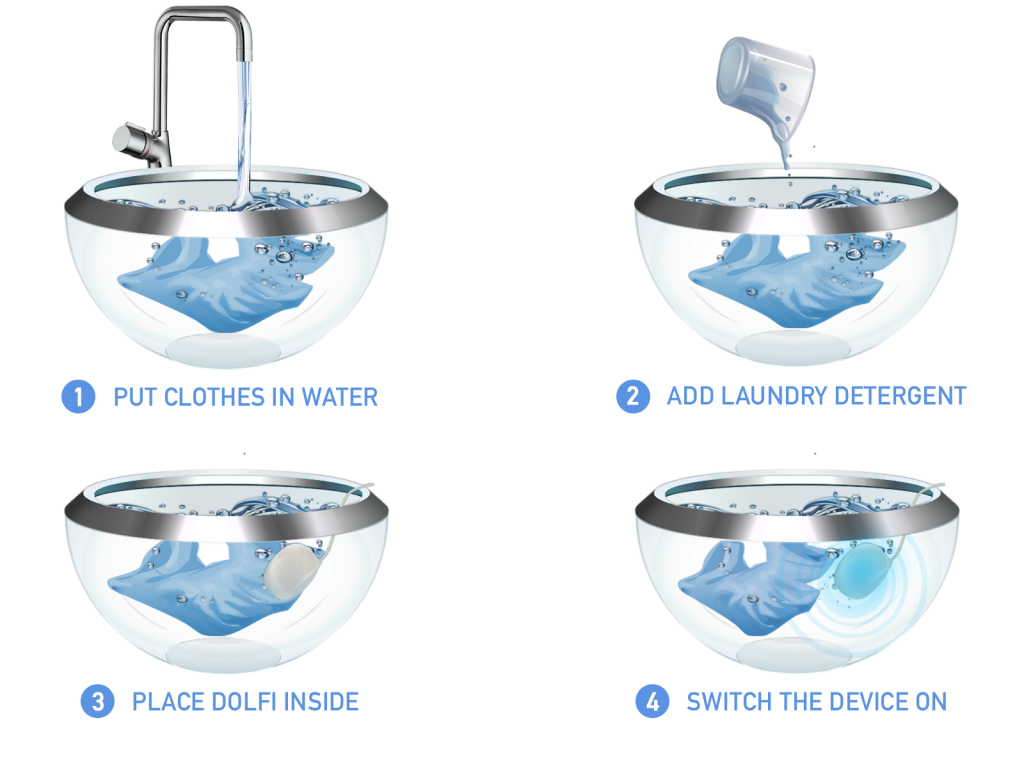
瑞士的MPI Ultrasonics公司將超音波清洗運用在Dolfi洗衣上,
由於是透過頻聲波製造出數以萬計的細小水流,特別適用於柔軟易損毀的布料,
一台Dolfi所需要的能源是一台標準型洗衣機的八十分之一,符合節能的概念。
文章出處:http://router-u.com/archives/3080
這是由Flexbot團隊所推出名為FlexPV的新產品。
基本上他是由一個150W的電動馬達所組成,裡面包含獨立的電源,陀螺儀與WIFI模組。
該裝置可以簡單的裝設在腳踏車,直排輪,或滑板上,理論上可以行走15公里。
